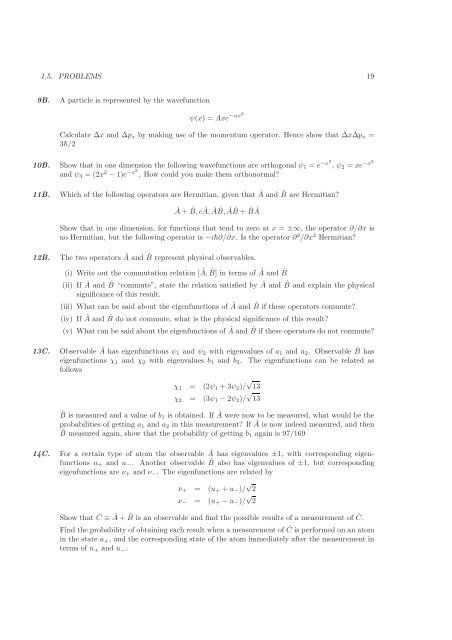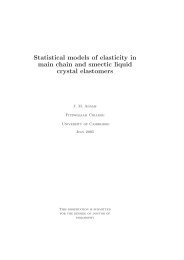Review of Quantum Physics
Review of Quantum Physics
Review of Quantum Physics
Create successful ePaper yourself
Turn your PDF publications into a flip-book with our unique Google optimized e-Paper software.
1.5. PROBLEMS 199B. A particle is represented by the wavefunctionψ(x) = Axe −αx2Calculate ∆x and ∆p x by making use <strong>of</strong> the momentum operator. Hence show that ∆x∆p x =3¯h/210B. Show that in one dimension the following wavefunctions are orthogonal ψ 1 = e −x2 , ψ 2 = xe −x2and ψ 3 = (2x 2 −1)e −x2 . How could you make them orthonormal?11B. Which <strong>of</strong> the following operators are Hermitian, given that  and ˆB are Hermitian?Â+ ˆB,cÂ,ˆB,ˆB + ˆBÂShow that in one dimension, for functions that tend to zero at x = ±∞, the operator ∂/∂x isno Hermitian, but the following operator is −i¯h∂/∂x. Is the operator ∂ 2 /∂x 2 Hermitian?12B. The two operators  and ˆB represent physical observables.(i) Write out the commutation relation [Â, ˆB] in terms <strong>of</strong>  and ˆB(ii) If  and ˆB “commute”, state the relation satisfied by  and ˆB and explain the physicalsignificance <strong>of</strong> this result.(iii) What can be said about the eigenfunctions <strong>of</strong>  and ˆB if these operators commute?(iv) If  and ˆB do not commute, what is the physical significance <strong>of</strong> this result?(v) What can be said about the eigenfunctions <strong>of</strong>  and ˆB if these operators do not commute?13C. Observable  has eigenfunctions ψ 1 and ψ 2 with eigenvalues <strong>of</strong> a 1 and a 2 . Observable ˆB haseigenfunctions χ 1 and χ 2 with eigenvalues b 1 and b 2 . The eigenfunctions can be related asfollowsχ 1 = (2ψ 1 +3ψ 2 )/ √ 13χ 2 = (3ψ 1 −2ψ 2 )/ √ 13ˆB is measured and a value <strong>of</strong> b 1 is obtained. If  were now to be measured, what would be theprobabilities <strong>of</strong> getting a 1 and a 2 in this measurement? If  is now indeed measured, and thenˆB measured again, show that the probability <strong>of</strong> getting b 1 again is 97/16914C. For a certain type <strong>of</strong> atom the observable  has eigenvalues ±1, with corresponding eigenfunctionsu + and u − . Another observable ˆB also has eigenvalues <strong>of</strong> ±1, but correspondingeigenfunctions are ν + and ν − . The eigenfunctions are related byν + = (u + +u − )/ √ 2ν − = (u + −u − )/ √ 2Show that Ĉ ≡ Â+ ˆB is an observable and find the possible results <strong>of</strong> a measurement <strong>of</strong> Ĉ.Find the probability <strong>of</strong> obtaining each result when a measurement <strong>of</strong> Ĉ is performed on an atomin the state u + , and the corresponding state <strong>of</strong> the atom immediately after the measurement interms <strong>of</strong> u + and u − .
















